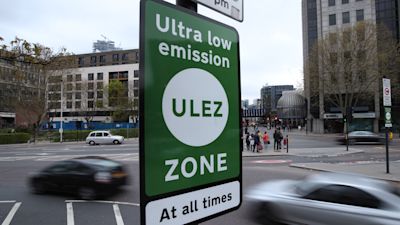Sadiq Khan unveils plan to expand Ultra Low Emission Zone to whole of London

London’s Ultra Low Emission Zone (Ulez) will be expanded to cover the entire city under plans announced by mayor Sadiq Khan to cut pollution and congestion.
Mr Khan has asked Transport for London (TfL) to consult on extending the scheme’s boundary from the North and South Circular Roads to the whole of Greater London by the end of next year.
Drivers of vehicles which do not comply with minimum emissions standards are charged a daily fee of £12.50 for entering the Ulez area.
The mayor’s office estimated that 135,000 vehicles would be affected on an average day if the boundaries are widened as planned.
Whether or not a vehicle is liable for the charge depends on how much nitrogen dioxide (NO2) it emits.
NO2 damages lungs and can exacerbate existing conditions such as asthma and lung and heart disease.
For diesel cars to avoid the charge they must generally have been registered after September 2015, while most petrol models registered from 2005 are also exempt.
Mr Khan has ruled out introducing a Clean Air Charge, which would have affected drivers of all but the cleanest vehicles.
He will also not go ahead with a proposal to charge drivers of vehicles registered outside London for entering the capital.
Announcing his Ulez expansion plan on a visit to Forest Hill School in south-east London, the mayor said the rising cost of living was a key factor in his decision but said he is "absolutely convinced it’s justified" for people to pay more "to save lives and protect the health of Londoners."
“I believe the proposal to extend the Ulez London-wide will have the biggest effect on emissions and congestion relative to the potential financial impact on Londoners as a whole.
“We are also proposing to introduce the biggest scrappage scheme feasible to help Londoners on low incomes, disabled Londoners and businesses.”
The Ulez was only expanded from the Congestion Charge area to the North and South Circular roads in October 2021.
But Mr Khan said there is “still far too much toxic air pollution permanently damaging the lungs of young Londoners and leading to thousands of deaths every year”.
The mayor has also asked TfL to explore how motorists can be charged on a per mile basis depending on how polluting their vehicles are, the level of congestion in the area and access to public transport.
But a City Hall document notes the required technology for such a scheme is “still years away from being ready”.
RAC head of roads policy Nicholas Lyes said expanding the Ulez is “preferable to the other charges that the mayor previously mooted”.
But he warned it is “vital” that Londoners have “enough time to upgrade to compliant vehicles”.
Andy Marchant, traffic expert at location technology firm TomTom said low emission zones disincentivise drivers of polluting vehicles from entering cities, but warned they will become “less important” as electric vehicles (EVs) become more widespread.
“When EVs become the norm, there won’t be any emissions-based restrictions preventing them from entering cities,” he said.
“There’s the possibility that this will lead to an increase in inner-city congestion, even if it generates zero tailpipe emissions.”